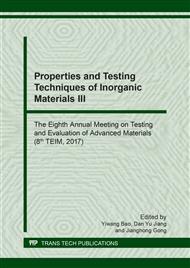p.3
p.8
p.13
p.19
p.24
p.31
p.36
p.41
On the Test Method for Determining Residual Stress on the Surface of Tempered Glass
Abstract:
The residual stress on the surface of tempered glass is very important for its safe service and the quality control. In this study, the sphere indentation and grazing angle surface polarimetry are compared to evaluate the surface residual stress of tempered glass. The test results showed that the measured results are similar, but the data dispersion of the sphere indentation method is little larger. The main reason is stemmed from the different tested area, of which residual stress is a mean value measured by the grazing angle polarization method. Yet for the indentation method, the residual stress in the micro region of glass is more susceptible to the inhomogeneity of material itself. However, it is difficult to select the right multiple optical path difference for the grazing angle polarization method, and it is only applicable when inspecting the tin surface of tempered glass, as well as the tin surface examination instrument. Thus, as a nondestructive testing method, indentation method can be widely used to measure the surface residual stress of glass without being influenced by other factors.
Info:
Periodical:
Pages:
19-23
Citation:
Online since:
April 2018
Authors:
Price:
Сopyright:
© 2018 Trans Tech Publications Ltd. All Rights Reserved
Share:
Citation:


